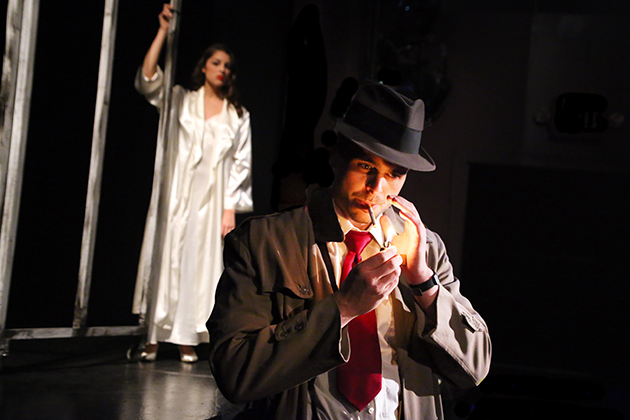
The actors, director, lighting and set designers, and others who produce theatrical productions typically start rehearsals with a script that guides them in what to say, how to move, and the look of the performance stage.
The creative team for “The Band of the Black Hand,” took a decidedly different path for the Connecticut Repertory Theatre production that opens March 26 in the Studio Theatre by using the creative approach known as “devised theater.”
Bringing the cast and crew together with the playwright and director to use collaboration and improvisation techniques, devised theater gives everyone involved a shared role in creating the new production, with the script constantly changing as ideas are tried, rejected, and new ones presented.
Combining shadow puppetry with film noir
“The Band of the Black Hand” began with conversations between Greg Webster, assistant professor of movement in dramatic arts, and Bart Roccoberton, professor of puppet arts and director of the Puppet Arts Program.
“I had gone to a showing a number of years ago that Bart was doing with students on Indonesian shadow puppetry,” says Webster. “That concept became very interesting to me in the world of film noir.”

The two professors discussed finding a project that would bring together shadow puppetry with the physical theater movement techniques of the renowned French actor and mime Jacques Lecoq taught by Webster in UConn acting classes.
Webster, a founding member and artistic director of the critically acclaimed Split Knuckle Theatre Company, took the idea to Nick Ryan, a rising playwright with Split Knuckle, and began researching film noir, the late 1940s and early 1950s Hollywood films most often centered on crime and detective fiction.
“We spent many months watching tons of film noir and drafting what could be a storyline that we could improvise and create a story around,” Webster says. “I’m really interested in film noir because it deals with deception and people not knowing what’s going on or the detective uncovering a grand scheme of darkness. The gray matter that film noir lives in is what we’re moving into in American television writing with shows like ‘Breaking Bad’ and ‘House of Cards.’ ”
An improvised storyline
“The Band of the Black Hand” tells the story of private investigator Jack Stone, who is hired to solve the savage murder of an investigative reporter. The backdrop for the story is a gang war where the Band of the Black Hand is taking over the city from the streets to the mayor’s office. The production incorporates contemporary shadow theater techniques, striking physical theater, and music composed for the play.
“There’s only brief moments when there’s not imagery on the screen,” says Roccoberton. “Greg started the process by saying we’re all equals. We’re creative individuals working together. We’re working with six performance students and four puppetry students. Their playfulness has been refreshing. To have one of our students come to me saying, ‘I have an idea; can I try this with the lights?’ Wow! Yeah! I turned to her and I said, ‘You just taught me something.’ The students have been amazing.”
He adds that shadow puppetry is used for the off-stage battles that are part of the story, a technique known as “Grande Guignole,” or theater of horror, inviting the audience to use their imagination throughout the production.
[The audience] need to meet us, imagine things, and create the illusion. You can never give them anything as spectacular as they can imagine in their heads. — Margarita Blush
“In realism you give the audience everything,” says Margarita Blush, assistant professor of performance and directing for puppet arts. “In our forms of theater, we want the audience to give us at least 50 percent. They need to meet us, imagine things, and create the illusion. You can never give them anything as spectacular as they can imagine in their heads.”
The inclusion of the technical designers in the development of the production is also a new experience for set and lighting designers who usually receive a script with information that allows them to propose ideas for scenery and lighting, says Roccoberton.
“We said to the designers, you’ve got to jump into the sandbox with us. Come and play and understand we are creating something from nothing. And they did,” he says. “The designers have all come to me to say, ‘I’m excited by what’s happening.’ It’s neat.”

The preliminary work for “The Band of the Black Hand” began last year when MFA students in Webster’s movement class began to explore characters and the storyline. Blush assisted in the class, introducing the use of shadow puppet techniques.
At times there are four different light sources on the shadow screen creating images, Roccoberton says.
“We’re trying to avoid, as much as possible, realism,” he says. “There is a morgue scene. One of the first things you see is a foot with a toe tag. You know exactly where you are. It’s a chilling moment. In another scene, Jack Stone is trying to escape, he climbs out of the window and you see the city in the background. The buildings start floating around behind him. It is living cinema.”
Discussing the production a week before the opening, Webster says the script continues to change.
“We’re on draft 5.5 now. The script itself keeps evolving and will likely continue to evolve until we put the lights out at the end of the show,” he says. “The group consciousness awakens something in the players and everyone in the room where we can have all different ideas of what can happen and suddenly after hours and hours of trial and failure something appears, and everyone goes: ‘Oh yeah!’ No one can really say it’s theirs. Who’s to say how it got there? That is truly magical to me.”
“The Band of the Black Hand” will be performed from March 26 to April 4 in the Studio Theatre, 802 Bolton Road, Storrs. For information go to www.crt.uconn.edu.



